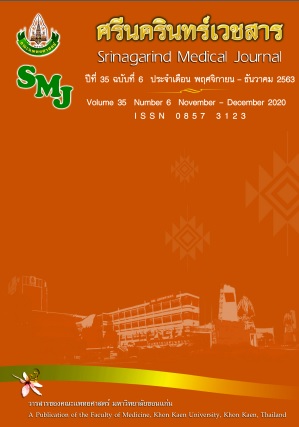Multiplex PCR for Identifying BCR-ABL Fusion Transcript Types in Northeastern Thailand Chronic Myeloid Leukemia Patients
Abstract
เทคนิค Multiplex PCR เพื่อระบุชนิดการกลายพันธ์ของจีน BCR/ABL ในผู้ป่วยโรคมะเร็งเม็ดเลือดขาวชนิด Chronic Myeloid Leukemia ในพื้นที่ภาคตะวันออกเฉียงเหนือ ประเทศไทย
กนกอร จูตะวิริยะสกุล*, กาญจนา จันทร์สูง
ภาควิชาอายุรศาสตร์ คณะแพทยศาสตร์ มหาวิทยาลัยขอนแก่น
หลักการและวัตถุประสงค์: ฟิลาเดลเฟียโครโมโซมเป็นโครโมโซมที่มีต้นกำเนิดมาจากการแลกเปลี่ยนซึ่งกันและกันระหว่างแขนยาวของโครโมโซม 9 และโครโมโซม 22 t(9;22)(q34;q11) พบได้ร้อยละ 90 ถึงร้อยละ 95 ในผู้ป่วยมะเร็งเม็ดเลือดขาวเรื้อรังชนิดมัยอิลอยด์ (CML) การแลกเปลี่ยนโครโมโซมดังกล่าวทำให้เกิดการสร้างจีนกลายพันธุ์ BCR-ABL โดยพบได้บ่อย ๆ มี 2 ชนิดประกอบด้วยชนิด b3a2 และ b2a2 ซึ่งอยู่บนโปรตีนขนาด 210 กิโลดาตัน (210 KDa) ชนิดอื่น เช่น e1a2 อยู่บนโปรตีนขนาด 190 กิโลดาตัน (190 KDa) และที่พบได้น้อยคือชนิด e19a2 อยู่บนโปรตีนขนาด 230 กิโลดาตัน (230 KDa) ชนิดของจีนกลายพันธุ์ของจีน BCR-ABL มีรายงานการค้นพบที่แตกต่างกันไปในแต่ละพื้นที่ แต่ยังไม่มีการรายงานความความถี่ของชนิดการกลายพันธ์ของจีน BCR-ABL ในผู้ป่วยมะเร็งเม็ดเลือดขาวเรื้อรังชนิดมัยอิลอยด์ ในพื้นที่ภาคตะวันออกเฉียงเหนือ ประเทศไทย การศึกษาครั้งนี้มีจุดประสงค์เพื่อรายงานชนิดของจีนกลายพันธุ์ BCR-ABL ในภูมิภาคตะวันออกเฉียงเหนือ โดยใช้เทคนิคมัลติเพลกพีซีอาร์
วิธีการศึกษา: เป็นการศึกษาย้อนหลังศึกษาในในผู้ป่วยมะเร็งเม็ดเลือดขาวเรื้อรังชนิดมัยอิลอยด์ผู้ใหญ่ในโรงพยาบาลศรีนครินทร์และโรงพยาบาลศูนย์ขอนแก่น ซึ่งเป็นโรงพยาบาลระดับตติยภูมิในพื้นที่ภาคตะวันออกเฉียงเหนือ ประเทศไทย โดยเก็บข้อมูลจากทะเบียนผู้ป่วยเป็นระยะเวลา 3 ปี (มกราคม 2560 ถึงมกราคม 2563) เลือดหรือไขกระดูกของผู้ป่วยมะเร็งเม็ดเลือดขาวเรื้อรังชนิดมัยอิลอยด์ผู้ใหญ่ถูกเก็บมาตรวจวิเคราะห์โดยใช้เทคนิคมัลติเพลกพีซีอาร์จากผู้ป่วยจำนวน 177 คน มีจุดประสงค์เพื่อจะระบุชนิดของจีนกลายพันธุ์ BCR-ABL ในกลุ่มผู้ป่วยมะเร็งเม็ดเลือดขาวเรื้อรังชนิดมัยอิลอยด์ ในภูมิภาคตะวันออกเฉียงเหนือประเทศไทย โดยใช้เทคนิคมัลติเพลกพีซีอาร์
ผลการศึกษา: ผู้ป่วยทั้งหมดให้ผลบวกชนิดใดชนิดหนึ่งต่อจีนกลายพันธุ์ BCR-ABL ผู้ป่วยส่วนใหญ่ร้อยละ 93.79 ตรวจพบว่าเป็นกลุ่ม Major โดยระบุว่าเป็นชนิด b3a2 และ b2a2 ร้อยละ 58.19 และ 35.59 ตามลำดับ ตรวจพบว่ามีจีนซ้อนกันระหว่างชนิด b3a2(p210) และ e1a2(p230) ร้อยละ 0.56 สำหรับชนิด e1a2 ซึ่งอยู่บนโปรตีนขนาด 190 นั้นถูกค้นพบ ร้อยละ 4.52 และชนิด e19a2 ซึ่งอยู่บนโปรตีนขนาด 230 นั้นพบจำนวนร้อยละ 1.14 และไม่พบการการซ้อนกันระหว่างโปรตีน 210 กับโปรตีน 190
สรุป: เทคนิคมัลติเพลกพีซีอาร์มีประโยชน์และประหยัดเวลาในการตรวจเพื่อระบุชนิดจีนกลายพันธุ์ BCR-ABL ซึ่งจะสามารถช่วยในการพยากรณ์โรคและการรักษาโรคมะเร็งเม็ดเลือดขาวเรื้อรังชนิดมัยอิลอยด์
คำสำคัญ: ชนิดการกลายพันธุ์ของจีน BCR-ABL; มัลติเพลทพีซีอาร์; โรคมะเร็งเม็ดเลือดขาวเรื้อรังชนิดมัยลิลอยด์
คำสำคัญ: Multiplex PCR; BCR-ABL Fusion Transcript Types; Chronic Myeloid Leukemia (CML) .
Background and Objective: Philadelphia chromosome is the chromosome originating from the reciprocal translocation between long arms of chromosome 9 and chromosome 22 t (9;22) (q34; q11), it presents in 90 - 95% of patients with chronic myeloid leukemia. The aberration results from a reciprocal translocation are creating a BCR-ABL fusion gene. There are two major forms of the BCR-ABL fusion gene, involving ABL exon 2, but including different exons of BCR gene. The transcript b3a2 and b2a2 codes for a p210 protein. Other fusion gene leads to the expression of an e1a2 transcript, which codes for a p190 protein. Its frequency varies in different populations but there are no data from northeastern Thailand. In this study we aimed to report BCR-ABL fusion transcript types in northeastern Thailand CML patients by Multiple Reverse Transcriptase-Polymerase Chain Reaction (Multiplex PCR).
Materials and Methods Retrospective descriptive and analytical study of all adult CML patients in Srinagarind and Khon Kaen hospitals, which is the main tertiary medical center in the northeastern region Thailand. Data has been collected from medical records for 3 years (January 2017 to January 2020). Peripheral blood or bone marrow samples were analyzed by multiplex PCR from 177 adult northeastern Thailand CML patients. Aim to identify BCR-ABL fusion transcript types in northeastern Thailand CML patients by Multiplex PCR.
Results: All patients examined were positive for some type of BCR/ABL rearrangement. The majority of the patients (93.79%) expressed one of the p210 BCR-ABL transcripts, b3a2 and b2a2 transcript types were detected in 58.19% and 35.59% respectively. Co-expression of b3a2 (p210)/e1a2 (p230) was detected in 0.56%. The expression of an e1a2 transcript type, which codes for a p190 protein showed 4.52%. And 1.14% was detected in e19a2 transcript type. Co-expression of p210/p190 was not detected.
Conclusions: Multiplex RT-PCR is useful and saves time in the detection of BCR-ABL fusion transcript types; the occurrence of these transcripts associated with CML can assist in prognosis and treatment of disease.


